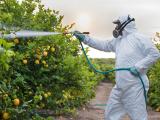Nov 24, 2009
WHO warns countries to stay on guard for H5N1 threats
The World Health Organization (WHO) today warned that recently confirmed cases of H5N1 avian influenza in poultry in Egypt, Indonesia, Thailand, and Vietnam serve as a reminder that the virus is still a threat to humans. In a statement posted on the Web site of the WHO Western Pacific regional office, the WHO said H5N1 in poultry poses two threats: illnesses to those in direct contact with sick birds and a risk that the virus could reassort with another influenza virus, such as the pandemic H1N1 strain. Dr Shin Young-soo, WHO regional director, said scientists are on alert for any reassortment, particularly one between the lethal H5N1 virus and the highly transmissible pandemic H1N1 strain. He said international partners and governments are building surveillance systems to identify virus changes and response capacity to reduce potential threats to human health.
Nov 24 WHO Western Pacific regional office statement
Study finds H5N1 transmission risk in highly exposed workers
A study of cullers and poultry workers who were exposed to large-scale H5N1 avian influenza outbreaks in Vietnam's Ho Chi Minh City between 2003 and 2005 confirmed that transmission was low, but that it is a risk in those who have heavy contact with the virus. The findings appeared yesterday in the journal Public Library of Science (PLoS) One. When investigators tested the blood of 500 poultry workers and cullers for H5N1 antibodies using microneutralization assays, all tests came back negative, but three samples showed serologic evidence of H5N1 infection, but below or at the lower end of cutoff values. The three subjects who showed evidence of exposure to the H5N1 virus were all cullers and had been involved in the activity for more than a year. They did not have poultry at home or in their neighborhoods. Two used only masks and gloves during culling; the other also wore coveralls and boots. None of the three reported any clinical symptoms in the month before blood samples were obtained.
Nov 23 PLoS One study
Community-associated MRSA rises 7-fold outside hospitals
Bacterial isolates sent to clinical microbiology labs from outpatient settings between 1999 and 2006 show a sevenfold increase in strains of community-associated methicillin-resistant Staphylococcus aureus (MRSA), which rose from 3.6% to 28.2% of all MRSA isolates, according to a new paper in Emerging Infectious Diseases. The analysis by researchers from Resources for the Future also finds that community MRSA strains are not replacing hospital strains but are adding to an expanding epidemic. Doctors and other healthcare staff who move back and forth between outpatient settings and hospital work may be an unwitting vector of community-MRSA strains into hospitals, where those strains are causing larger amounts of disease, the researchers say.
Nov 24 Emerg Infect Dis study






















